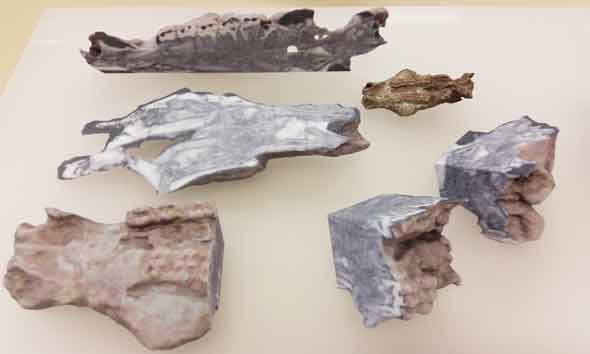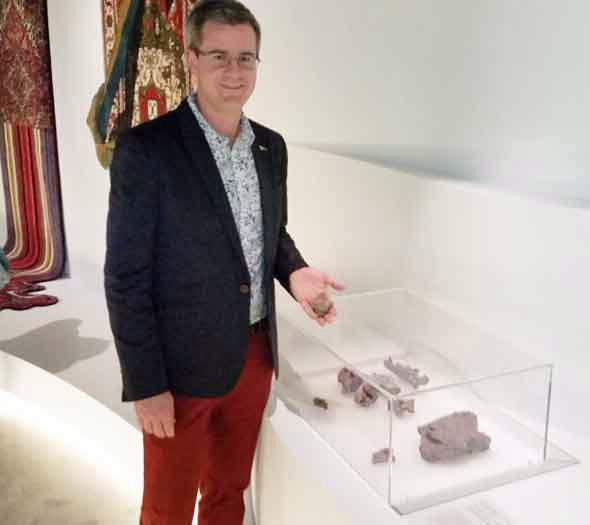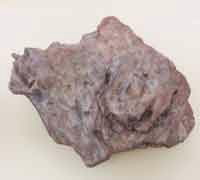ANSTO has contributed a striking replica of a Jurassic fossil to the Sydney Design Festival Out of Hand: materialising the Digital exhibition which is now on display at the Museum of Applied Arts & Sciences Powerhouse Museum in Sydney.
 |
| 3D printed replicas of Jurassic fossils with neutron images on surfaces that reveal anatomical detail |
Joseph Bevitt, Manager of ANSTO’s Research Office and an experienced neutron beam instrument scientist, was involved in supplying 3D printed sculptures of a 195-million-year-old fossilised dinosaur embryo and skull of a mammal-like reptile. The objects feature both neutron-CT data from the Dingo neutron imaging instrument and photogrammetry. “The 3D sculpture demonstrates the power of neutrons to reveal fossilised soft tissue remains, such as the brain, eyes and facial muscles non-invasively,” said Bevitt.
The stem-mammal and dinosaur embryo replicas are on display alongside one another, as fossils of these stem-mammals were found alongside the nests of 195-million-year-old Early Jurassic period nests of dinosaurs in the Yunnan Province in southwest China.
The 3D replicas of the two original fossils were manufactured by WYSIWYG 3D Pty Ltd at Peakhurst, NSW.
“Fossilised soft-tissue remains of prehistoric animals are rare, yet palaeontologists are discovering remarkable levels of preservation at a number of sites around the world,” said Bevitt.
 |
| ANSTO's Jospeh Bevitt stands at the exhibit case containing the 3D replicas of Jurassic fossils holding the original specimen |
“Not only do such fossils of dinosaurs and proto-mammals, or ‘mammal-like reptiles’, yield insights into the biology and behaviour of these ancient animals, but they also provide detailed information on contemporary environmental conditions, fossilisation and evolutionary processes.”
As Bevitt explained in the exhibition catalogue, when fossilised dinosaurs and other organisms are discovered, it is common for researchers to physically extract the fossilised bones from the surrounding matrix to accurately describe the species. However, remnant details of soft-tissue remains such as skin, flesh, hair, feathers and even brain structure are compromised during extraction.
The neutron-CT cross-sections revealed as a 3D printed jigsaw puzzle for the exhibition correspond to the displayed fossil skull of a juvenile Bienotherium, an early ancestor to all mammals. The specimen (pictured below right) was found in the Lufeng Formation alongside fossilised nests and hatchlings of the displayed Lufengosaurus, one of the earliest known dinosaurs.
The Lower Lufeng Series is a Lower Jurassic (175– 200 million year old) sedimentary rock formation found in Yunnan Province, in far southwest China.
The Lufengosaurus specimen is the first definite embryo, and therefore the earliest stage of dinosaur development recorded so far from the Lufeng Formation.
 |
“Remarkably, this specimen retains preserved organic remains, and these are under continuing investigation,” said Bevitt.
The Bienotherium specimen is remarkable for its preservation of brain structure, optic system and facial muscles.
“The embedded features were only revealed using neutron micro-CT, a 3D imaging technique. The 3D printed puzzle allows a unique perspective into the rich and diverse insights palaeontologists are yielding from these remarkable fossils.” said Bevitt, who attended the opening on 3 September at the Powerhouse Museum.
The cutting-edge exhibition showcases over 90 artworks and objects materialised using new digital technologies and the world’s best design practices. The displays explore the increasingly important role of digital manufacture in science, contemporary art, fashion, design and architecture.
The exhibition highlights that new digital technologies, such as 3D printing, provide a new capacity to mimic and model natural forms, from microscopic unicellular organisms to the macroscopic environment, to better understand the natural world.
Dingo is a neutron radiography/tomography/imaging instrument located at the OPAL research reactor supported by the National Collaborative Research Infrastructure Strategy.
The Out of Hand: Materialising the Digital exhibition is open now at the Powerhouse Museum, Ultimo (Sydney), until 25 June 2017.
Published: 08/09/2016


